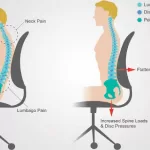OFFICE ERGONOMICS AND ITS IMPORTANCE IN PREVENTION OF POSTURAL PAIN
Office work is an important aspect of modern day life, but it can also come with its own set of physical and health problems. One such problem is postural pain, which is a common issue faced by people who spend long hours at their desk. The key to preventing this type of pain is to understand the concept of office ergonomics and to implement proper ergonomic practices in the workplace.
WHAT IS OFFICE ERGONOMICS?
Office ergonomics is the study of how to design a work environment that is both comfortable and efficient. This includes everything from the desk and chair to the placement of the computer and other equipment. The goal of office ergonomics is to minimize the risk of injury and to maximize comfort and productivity.
WHY IS OFFICE ERGONOMICS IMPORTANT FOR PREVENTION OF POSTURAL PAIN?
Sitting in a poorly designed workspace for extended periods can cause strain on the neck, back, and shoulders, leading to postural pain. An ergonomic workplace, on the other hand, helps to distribute the weight evenly across the body and reduce the stress on any one area. It also helps to prevent fatigue, which can contribute to postural pain.
BIOMECHANICAL RELATIONSHIP TO POSTURAL RELATED PAIN
The biomechanics of the human body play a crucial role in determining the likelihood of postural pain. Poor posture, combined with long hours spent in the same position, can lead to strain and injury. The muscles, ligaments, and joints in the body are all interconnected, and when one area is strained, it can have a domino effect on the rest of the body.
CAUSES OF POSTURAL PAIN
There are several factors that can contribute to postural pain. Some of the most common include:
· Poor posture
· Long hours spent in the same position
· Poorly designed workspaces
· Poor lighting
· Lack of movement and exercise
· Repetitive motions
· Carrying heavy bags or backpacks
PREVENTION TIPS
To prevent postural pain, it is important to follow proper ergonomic practices. This includes:
· Using a chair with good lumbar support
· Keeping the computer screen at eye level
· Positioning the keyboard and mouse within easy reach
· Taking frequent breaks to stretch and move
· Practicing good posture
· Using a headset instead of cradling the phone between the ear and shoulder
· Making sure that the workspace is well lit and that the computer screen is free of glare
PHYSIOTHERAPY TREATMENT FOR POSTURAL PAIN
If you are experiencing postural pain, physiotherapy can be an effective way to manage the symptoms and prevent further injury. Some of the treatments that may be recommended include:
Manual Therapy: This type of therapy involves the use of manual techniques such as , stretching, and joint mobilization to relieve pain and improve mobility.
Posture Correction and Posture Correction Exercises: A physiotherapist can help you identify the root cause of your postural pain and provide exercises to correct any imbalances in the body.
Ergonomics Tips to Prevent Posture Corrections: Your physiotherapist can also provide tips on how to create a more ergonomic workspace to prevent postural pain in the future.
Office Stretches and Exercises: Regular stretching and exercise can help to prevent postural pain. Your physiotherapist can provide exercises that are specifically designed for office workers.
Strengthening Exercises: Strengthening the muscles in the neck, back, and shoulders can help to support good posture and reduce the risk of postural pain. Your physiotherapist can recommend specific exercises to target the muscles that are most affected by postural pain.
It is important to note that everyone’s body is unique and what works for one person may not work for another. Your physiotherapist will assess your individual needs and provide a customized treatment plan to help you manage your postural pain.
In conclusion, postural pain is a common issue faced by many office workers, but it can be prevented and managed through proper ergonomic practices and physiotherapy treatment. By making small changes to your workspace and incorporating regular stretching and exercise, you can reduce the risk of postural pain and maintain a healthy and pain-free body.












